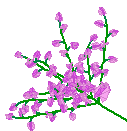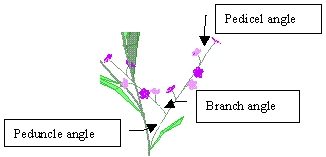Inflorescence parameters
An inflorescence is structure that holds flowers. These are examples of some inflorescences.





The parameters in the Primary inflorescences and Secondary inflorescences sections describe how inflorescences are created, grow, and are drawn. This explanation covers both primary (female or hermaphroditic) and secondary (male) inflorescences.
Stalk color, pedicel color
The inflorescence stalk is the main stem of the inflorescence that connects to the plant. The pedicel is the small stem that connects each flower to the stalk.
Number of flowers on main branch, per secondary branch
Inflorescence branches come off the main inflorescence stem. Only one level of branching is supported. For a spike inflorescence, put all your flowers on the main branch and none in secondary branches. For an umbel (like an umbrella upside-down), place all the flowers in secondary branches.
Number of secondary branches
If you want your inflorescence to have branches (such as in the fourth example above) you should set this number higher than zero. As with the placement of inflorescences themselves, you need to set this as an absolute number. Try seeing how different numbers of branches look on the inflorescence.
Inflorescence branches are alternate
If this parameter is answered “yes”, PlantStudio will place all the secondary branches you specify one at a time on the stem. If you choose “no”, which means “opposite”, two branches will appear at a time. This is the same as the alternate/opposite leaf arrangements.
Angle of inflorescence branch, pedicel, peduncle
The peduncle is where an axillary inflorescence comes off the main plant stem. The pedicel is the flower stalk.

Flowers spiral around main stem
Normally you will want to leave this turned on; if it is turned off the flowers line up along the stem in perfect order.
Head type (like sunflower)
If this parameter is set to “yes,” the individual flowers in an inflorescence are drawn not along a stem but around in a circle. This produces an effect like a sunflower or daisy, though it is not botanically accurate.
Pedicel taper index
This parameter causes pedicels (flower stems) to taper as they approach the flower or fruit 3D object, so that the intersection of stem and 3D object looks more natural. For no tapering, set this index to 100%; for tapering, lower the index. Tapering works only on the screen and in DXF output; it doesn’t work for POV output. Tapering looks best in 2D output when there are more line segments per line (change the parameter General parameters: Number of segments to draw to create curved line). If your inflorescence stems are already thin, you won’t be able to see much tapering.
Apical (terminal)
This parameter is only used if you have both primary and secondary inflorescences on the plant, one in the apical position and the other in the axillary position. In that case you need to identify which type of inflorescence goes where. Otherwise you can ignore this parameter.
Optimal biomass, Minimum/maximum days for meristem to create, Minimum fraction of optimal biomass needed to create/make flowers, Minimum/maximum days to grow
See the section on A common suite of parameters for growthA_common_suite_of_parameters_for_growth>second.
Days for all flowers to develop
This is the only parameter that determines how long it takes for flowers to appear on the inflorescence. If you specify a number of flowers and end up with fewer, the flowers might not have time to appear before the plant reaches the end of its life cycle. Try reducing this number or increasing the parameter General parameters: Age at maturity.
Flowers develop from top to bottom
In most plants the oldest flowers are at the bottom of the inflorescence, but in a few it is the other way around. Turn this parameter on if you want reverse timing of flower development. Note that this parameter will only have an effect if it takes a while for all the flowers to appear on the inflorescence – otherwise they will all be the same age (and make the same biomass demands) at any time so you won’t see any difference in size.
Bracts
Inflorescence bracts are leaf-like structures that can be found at the base of inflorescences.

Created with the Personal Edition of HelpNDoc: Free EPub producer